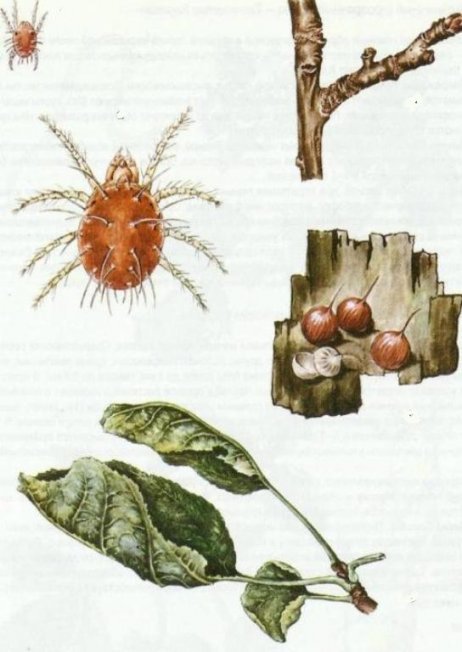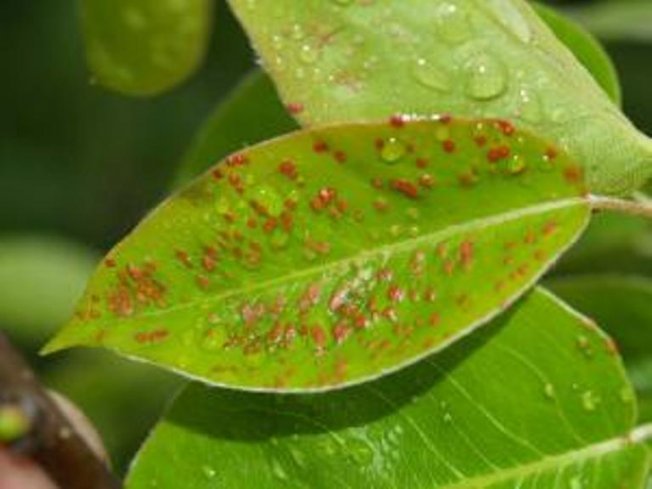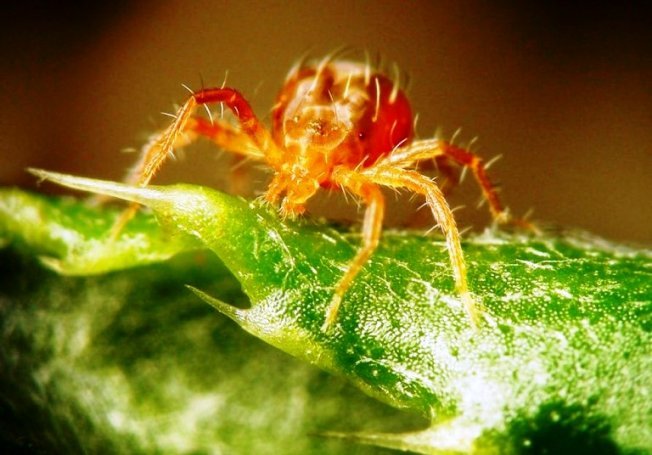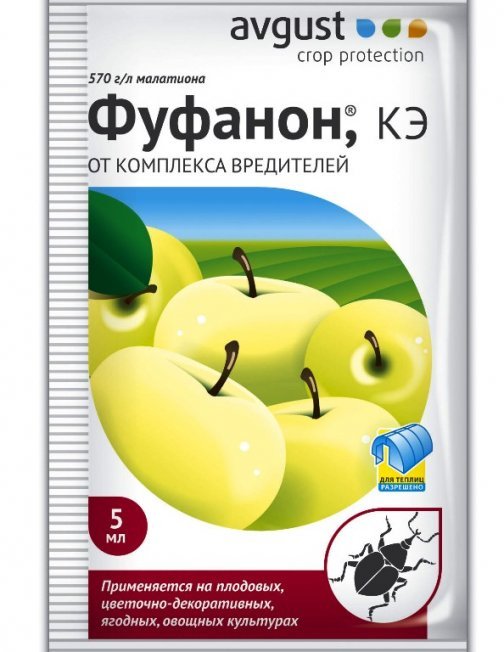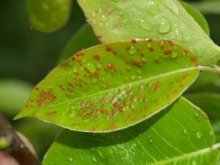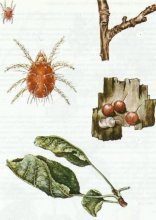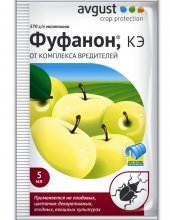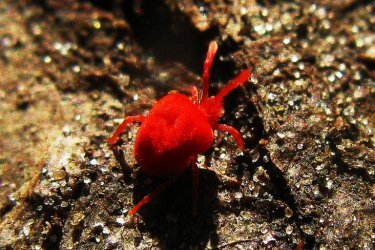Apple red mite, photo and description, how to get rid of and prevent the spread
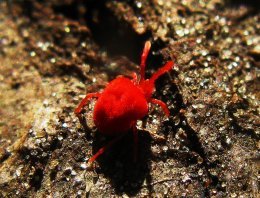
Cancer scientists claim that there are about 50 thousand species of ticks spread around the world. It is not surprising that gardeners periodically have to observe the invasion of these pests. Red apple mites and spider mites pose a great danger to the garden.
Content:
- Fruit mites, photo and description
- Symptoms of the lesion
- Important points in mite development that gardeners need to consider
- How to prevent the spread
- How to get rid of ticks using traditional methods
- Chemical remedies
Fruit mites, photo and description
Among the most common garden tree pests. Thanks to their specific piercing-cutting mouthparts, mites draw juices from the leaves, which leads to the withering and falling of the latter, the affected fruits become smaller and wrinkled.
Severe infestation of the garden can lead to the loss of more than a third of the harvest.
What the apple red mite looks like can only be seen in a photo or under a magnifying glass, because... its dimensions are very small, the length of an adult is 0.3 - 04 mm, males are smaller than females.
It is polyphagous and can feed on the sap of representatives of different plant families: Rosaceae, elm, beech, birch, and walnut. Affects all fruit trees, roses, and indoor plants.
It can reproduce bisexually and parthenogenetically.The number of generations per year is:
- in warm climates 7-9 generations;
- in cool conditions - from 3 to 4.
The female lays from 60 to 150 eggs per season. Only eggs laid by females overwinter. Adults and larvae die with the onset of winter.
Reproduction, development, and feeding of the red apple mite occurs at a temperature of about +21 C; development stops at a temperature of + 8 C.
The life of an arachnid pest consists of 4 stages:
- eggs;
- larvae;
- nymphs;
- imago.
The body shape of adults is oval, the color ranges from light red to cherry, and there are black spots on the sides. Eggs and larvae have a red color of varying intensity. During the nymph stage, they become yellowish-brown or reddish-brown in color.
They lead a sedentary lifestyle, high survival rate is ensured by the ability to adapt to the most extreme conditions of existence in any of the climatic zones.
Let's watch an interesting video about the red apple mite:
Symptoms of the lesion
You can notice the presence of red apple mites on trees by the appearance of numerous light spots on the affected leaves. They are especially noticeable near the veins. The leaves themselves take on a gray-red color and look as if they are dusted with road dust.
Flowers, shoots, fruits, and succulent shoots can be damaged by the pest. The larvae live and feed on the bottom of the leaves.
Upon careful inspection of fruit trees, it is not difficult to identify mite damage.
Mites infestation begins from the inside of the tree crown, then they move higher along the trunk. A severely affected plant may take on a pinkish or reddish hue. Damage and leaf fall can cause the tree to lose up to 40% of its chlorophyll.
Important points in mite development that gardeners need to consider
Every day, a female tick lays 2 to 4 eggs. The laying process continues until late autumn, stopping when the temperature drops to + 9 C. Overwintering of the pest occurs in the stage of eggs laid in cracks in the bark, at the base of growths, in the forks of branches, and the recesses of knots.
Females begin laying eggs suitable for wintering in the second half of summer.
The larvae emerge from the eggs with the onset of warm weather, in late April-early May, as soon as the buds begin to bloom. The appearance of adult females occurs at the end of May; after a few days they are able to reproduce offspring.
Unlike other pest species, the female red apple mite does not form a web.
If the conditions are favorable, then no more than 7 days pass from the laying process to the formation of an adult individual feeding on plant sap.
How to prevent the spread
You can avoid massive damage to your garden if adhere to tree care rules:
- in autumn, all fallen leaves should be removed from the tree trunks;
- using a metal brush, remove flaky remains of old bark;
- old and dry branches should be trimmed and burned.
Thus, the future wintering sites of new generations of the pest will be destroyed.
Catching belts that collect a fairly large number of pests are effective. They need to be systematically treated with boiling water to kill arachnids and insects.
Moisture and coolness prevent the red apple mite from multiplying. We cannot influence the weather. But watering a tree efficiently, at least several times a season, is within the capabilities of most gardeners.
How to get rid of ticks using traditional methods
If there are not very many pests detected, then you can try to do without the use of pesticides.
To destroy mites, use a strong tobacco infusion, prepared by infusing 1 kg of tobacco dust or crushed shag in 10 liters of water. The infusion is filtered, another 10 liters of water and 50 g of laundry soap are added to improve adhesion. It is advisable to repeat spraying the tree after a week.
To treat trees, they also use an infusion of chamomile; 1 kg of dried herb is needed per bucket of water. The infusion is prepared for 10 hours, filtered, then sprayed onto the trees. The procedure should be repeated after a week.
Chemical remedies
Massive infestation of red apple mites, especially if there is a threat to the harvest, requires the use of insecticides.
Chemical treatment is carried out twice:
- immediately after the formation of ovaries;
- one month before the planned harvest.
In summer and spring, it is also practiced to spray trees with ether sulfonate (3 g of powder per 1 liter of water) or a solution of colloidal sulfur (10 grams of sulfur per 1 liter of water per 1 liter of water).
If a mass reproduction of mites is detected in the garden, treatment with pyrethroid preparations against the codling moth is not carried out.
If there is a threat of pest infestation, treatment with specific acaricides is recommended:
- Demitan,
- Apollo,
- Nissan,
- Neoron.
In case of severe damage, insectoacaricides will give a good effect:
- Fufanon,
- Fitoverm,
- Danadim.
A chemical treatment method is also used, the trees are sprayed (washed):
- pyrethroids,
- organophosphorus compounds,
- mineral oils.
It is possible to use biological pesticides based on avermectins against pests.
Let's watch a useful video about effective methods of garden pest control:
Apple red mite poses a serious threat to garden trees. It is completely safe for humans, it does not feed on blood, and contact with this arachnid can only cause allergies.
Pests

